[COVID-19] To help mitigate COVID’s impact on small businesses, Kolau is waiving the fee to create a FORBES Award-Winning website with e-commerce enabled.
Create your website quickly and easily clicking here – Offer available for a limited time only.
Do you remember the scene in Alice in Wonderland where Alice asks the Cheshire Cat which way she ought to go?
“Well, that depends on where you want to get to,” the cat responds.
“Oh, it really doesn’t matter,” Alice replies.
“Then, it really doesn’t matter which way you go,” the cat concludes.
This passage teaches us a valuable lesson: Knowing where we want to go is important in order to get there. Therefore, knowing how to write a marketing plan allows you to draw your road map and discover what path to take to achieve your goals (to attract and retain customers).
A marketing plan doesn’t have to be extensive or complicated. Rather, the best marketing plans are short and simple. However, the key to writing an effective marketing plan lies in a great paradox: the difficulty of achieving simplicity.
In the words of Leonardo Da Vinci:
Simplicity is the ultimate sophistication.
Similarly, Steve Jobs discussed the idea when he said, “Simple can be more difficult than complex.” Even Albert Einstein himself said, “If you can’t explain it simply, you don’t understand it well enough.” However, it might be aeronautical engineer Kelly Johnson who alluded to this concept the best using four simple letters: KISS—“Keep It Simple Stupid.”
This guide will help you discover how to make a marketing plan in a simple way, based on the KISS concept and the extended model known as the “1 Page Marketing Plan.” This model has been defended by numerous marketing academics including Philip Kotler but was spread widely by entrepreneur Allan Dib through his best-seller of the same name.
Is it Essential to Have a Marketing Plan?
Marketing plans are a tried and true method that are continuously used all over the world for companies big and small. However, in the SME universe, it seems that the concept or, at least its implementation, is not as widespread as it should be.
According to a recent study carried out by Outbound Engine, 50 percent of SMEs don’t have an established marketing plan. The lack of this piece of the business puzzle can result in a stagnation or even a reduction of sales for a company.
While no one is sure why SMEs typically lack a sound marketing plan, it may be due to the fact that marketing plans—traditionally speaking—are perceived to be complex documents more than 100 pages in length. This is seen as a great waste of time and resources to most business owners who are more focused on meeting customer demands and staying within their set budgets.
However, it doesn’t have to be that way. Marketing plans should always be simple. As Allan Dib says in his book, the 64/4 rule should always be applied to any marketing plan:
The 1 page marketing plan is 4% of the effort generated by 64% (or more) of the results in your business.
So, it can be assumed that SMEs choose to shy away from marketing plans for their perceived complexity, but it doesn’t prove whether or not a marketing plan is essential for the long-term operation of a company.
Taking into account that a report by the Press and Communication agency found that 87 percent of SMEs that closed in 2018 didn’t have a professional marketing plan, it’s safe to say that marketing plans are essential for a business’s long-term success.
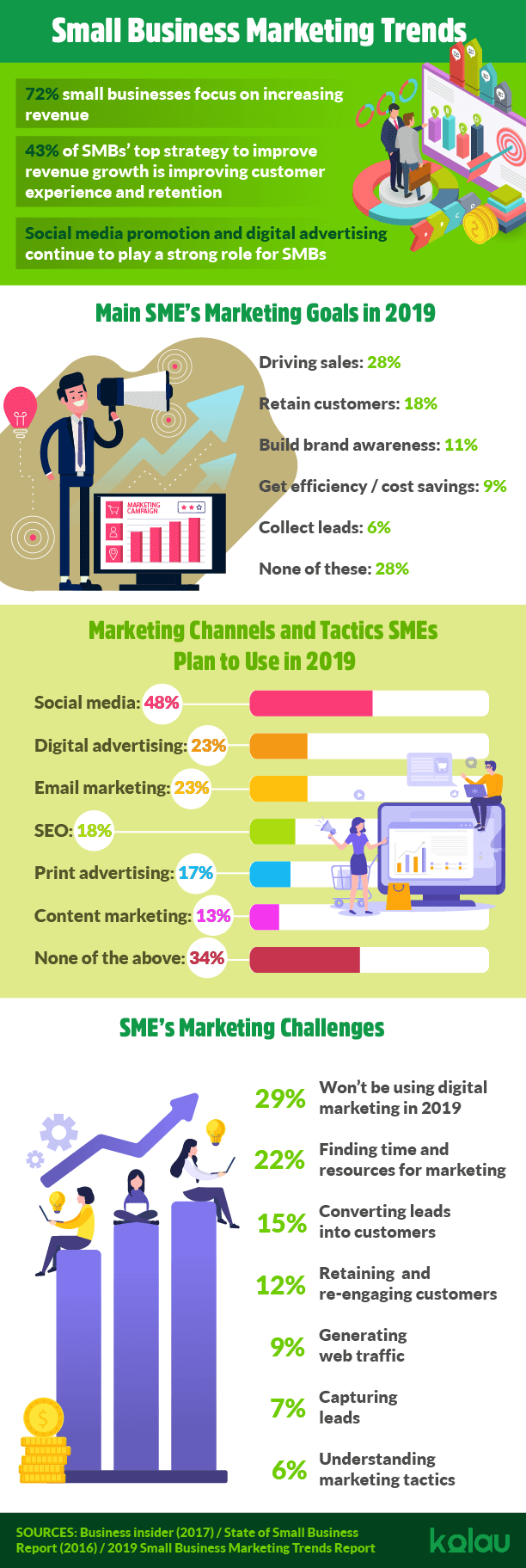
What is the Purpose of a Marketing Plan?
A marketing plan can help you organize your marketing strategies and focus on achieving your goals for your company.
As defined by Sally Dibb and Lyndon Simkin in their book, Marketing: Concepts and Strategies, “marketing planning is a systematic process involving the assessment of marketing opportunities and resources, the determination of marketing objectives and the development of a plan for implementation and control.“
To give you a clearer idea, your one-page strategic marketing plan should allow you to organize your marketing strategies into three phases precisely related to your customers’ purchase cycle:
- Before your potential customer makes a purchase.
- During the purchase.
- After your potential customer has bought and officially become a customer.
At the same time, it should allow you to answer the following questions about your business:
- Who do you want to reach (your target audience)?
- What do you mean (your message for your target audience)?
- How are you going to reach them (the means you will use to reach your target audience)?
- How are you going to capture their interest (your lead capture system)?
- How are you going to establish a relationship with them (your lead nurturing system)?
- How are you going to turn them into customers (your conversion strategy)?
- How will you do it to offer a world-class experience?
- How will you increase the value of your customers?
- How will you do it to be recommended (your referral program)?
These nine questions are the starting point and the backbone of everything your marketing plan should contain and this is how the one-page marketing plan proposed by Allan Dib is structured.
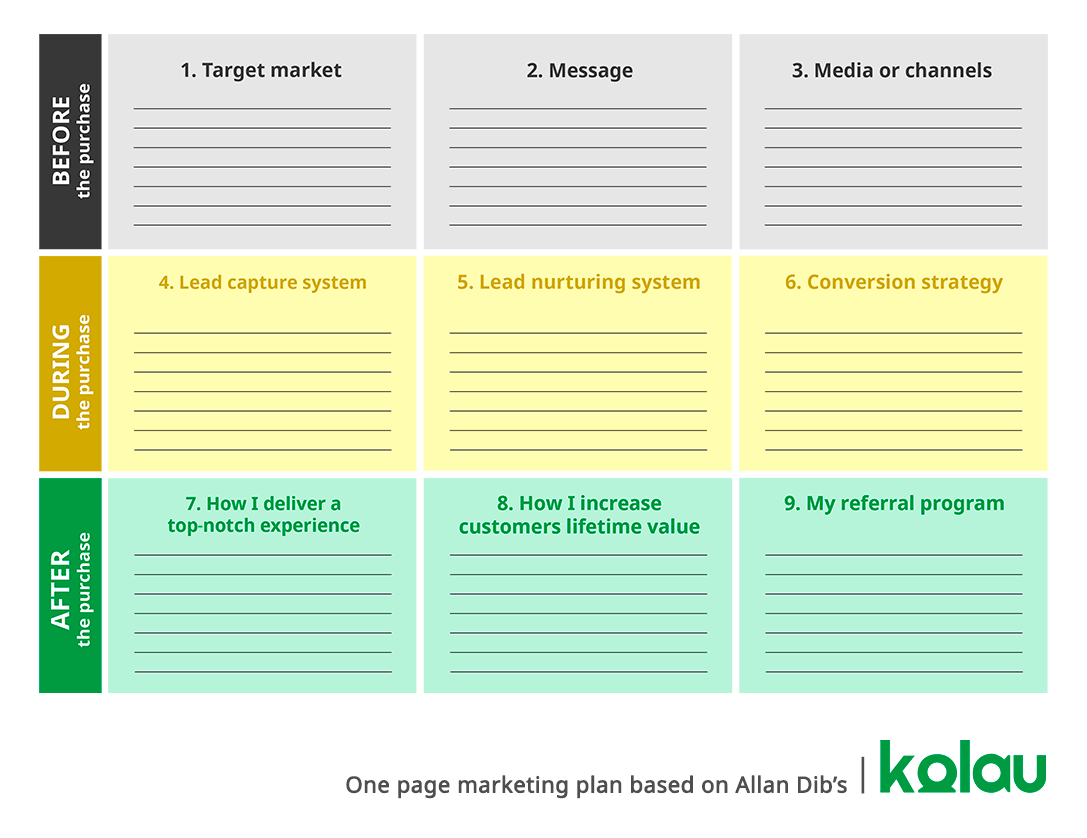
To build your own one-page marketing plan, follow this step-by-step guide based on the nine questions above.
Step 1: Find and analyze your target audience
The key to the success of any business often lies in what it knows about its potential customers. A business needs to know their clients perfectly including demographics, location and spending habits in order to offer them a product or service completely suited to their needs.
Today, mass marketing is no longer meaningful and directing your products or services to “everyone” for fear of losing potential customers is the main mistake many small businesses make. It is impossible to do something that suits everybody’s needs and, at the end of the day, you’ll have a better chance of getting noticed when addressing a smaller audience than you would trying to capture the attention of a large pool of customers.
You may be thinking that limiting your audience will limit the growth of your business, but this simply isn’t true. You can always create new products or services aimed at new “small pools” that together can exceed the size of the large pool you initially wanted to address.
Therefore, start by finding a market niche and dominating it by creating a product or service along with a well-written message that responds to the needs of this segmented group.
Think about it this way, when you break a bone, you’d rather see a specialist than a general practitioner. The same idea can be applied when choosing between similar businesses. By establishing yourself as a specialist and not a general practitioner, you can grow your business by attracting people who need your product or service instead of attracting people who just have an interest in what you’re offering.
More so, mastering a niche allows you to set a higher price since those who need your product or service know that you are offering exactly what they are looking for and trust that the quality will be better due to the fact that you are a specialist in your field.
Analyzing your potential customers (either through surveys or through the definition of your ideal client), you will be able to figure out how to achieve your business goals by optimizing your resources and knowing what trends to look for.
In the era of 1-to-1 communication, you need to personalize your communications and your actions based on what you know about your potential customers. According to a Salesforce Research survey of more than 6,700 consumers worldwide, it is estimated that 75 percent of consumers will want to find a personalized shopping experience by 2020.
For example, the website of the online fashion store Zalando shows a subscription form for its newsletter that asks its potential customers to indicate if they are interested in fashion for men or women.
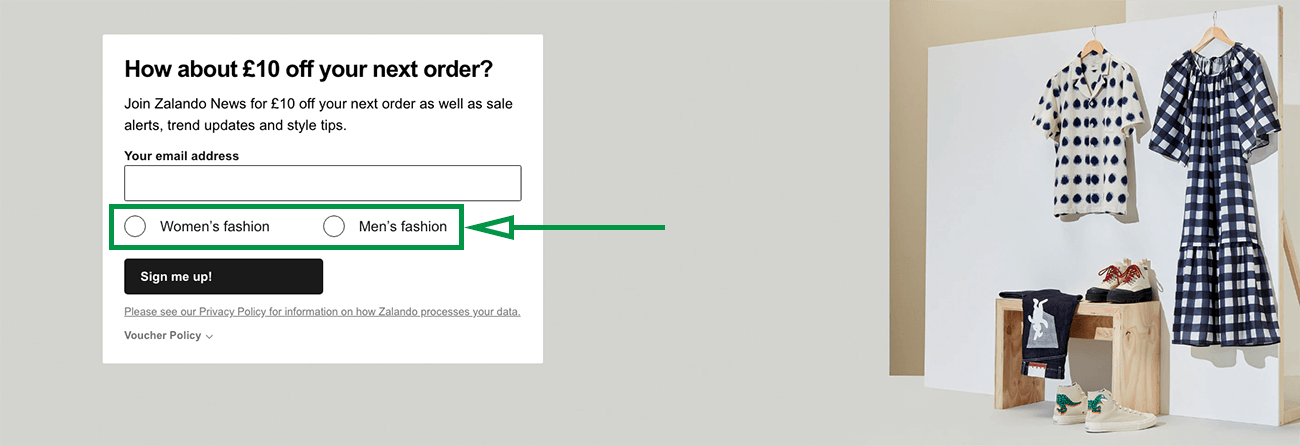
This detail allows them to determine the person’s gender so they can personalize the emails they’ll send to them to show only what fits their interests.
You can have more than one client profile, so analyze and define each profile to know exactly who your audience is, where you can find them and what message you want to deliver to them.
To do this, you can rely on the popular 5W + 1H model widely used in journalism and research:
- Who is your client?: Are they a private individual, a company, a man, a woman, a child, a teenager? How old are they?
- What does our client want?: Are they looking for an expensive or cheap product? Do they prefer quality? Are they looking for personalized attention?
- When do they buy?: Do they do it frequently? Do they make planned purchases or are they more spontaneous?
- Where is our client?: Where do they live or stay? What sites do they visit (both in the real world and online)?
- Why do they buy?: What needs do they have and why would they want to buy your products or services?
- How do they buy your product or service?: Do they buy in large quantities or individually? Do they do it online or do they prefer to go to a physical store? What payment methods do they use?
By answering these questions, you can develop multiple client profiles that will serve as the first step in your marketing plan.
Step 2: Build your marketing message
Once you determine your target audience and create client profiles based on that audience, it’s time to create a message to get their attention. This has to be done properly since it can be the difference between reaching your audience and talking to a wall.
A message with a purpose
Every marketing message you add to your plan needs to exist to achieve a single goal. This can be anything from your potential customers contacting you, visiting your physical store, filling out a form, remembering your brand or buying a specific product or service.
In the same way that you have selected a specific target audience to focus all your efforts on, you must also select a specific goal for your message and focus on it.
Base your message on a unique sales proposition
A Unique Sales Proposition (USP), is a concept that is used to refer to the factor that differentiates your product from that of your competition when it comes to selling it.
To define your unique sales proposition, you must be clear about why your business exists (your mission) and why people should buy from you and not from your competition. For example, the mission of Microsoft, as the company itself explains on its website, is “to empower every person and organization on the planet to achieve more.”

As you can see, its purpose is not only to sell operating systems, programs or devices like any other software company. Microsoft sells “productivity” just as Coca-Cola sells “happiness.” What are you selling?
Do an experiment. Do you think that if you remove the logo and name of your company from your website, your customers could still recognize you? If yes, it means that you have defined your unique sales proposition well. If not, and your website looks like that of any other company in the sector, you need to work on it.
Keep in mind that selling “quality” or a “good service” will not allow you to stand out, since it is something that your audience already expects from you.
Create your unique sales proposition based on what your potential customers want to achieve. People don’t want your product or service, they want what your product or service will allow them to achieve. Think about it.
Keep the medium in mind when creating the message
In his book Kotler on Marketing, Philip Kotler, with good reason, states:
The decision on the design of the message interacts with the decision of the medium [through which it will be transmitted].
Your message and its purpose must be defined with the characteristics of the medium you choose to transmit it in order for the message to be effective.
For example, imagine that you own a sushi restaurant and your goal is to get your potential customers to make a reservation through your ad. You are considering creating ads on Instagram and buying a space in a local magazine. The nature of these two platforms is very different so your message should be presented in different ways.
The magazine’s ad format is more limited consisting of text and an image. The most effective option will probably be to focus your message on getting the potential customer to call your business. Therefore, highlighting, above all, your phone number is one of the most important factors.
Instead, on Instagram you can use photos or videos, add emojis in the text to get attention and direct your potential customers directly to your website to make an online reservation.
In this example, the goal is the same and the message is the same but the way the message is delivered varies based on where the advertisement is placed.
Don’t talk only about your company and your product
Obviously, you have to present your product or service to the public to sell it, but don’t fall into the mistake of talking only about its characteristics and how good your company is. Focus on talking about the benefits it provides and how it can offer a solution to a problem or concern your potential customers face.
For example, Domino’s Pizza launched an effective marketing message with an excellent single sale proposal highlighting a benefit that differentiated themselves from their competitors. The message read: “Receive a hot and fresh pizza at your door in 30 minutes or less or it’s free.”
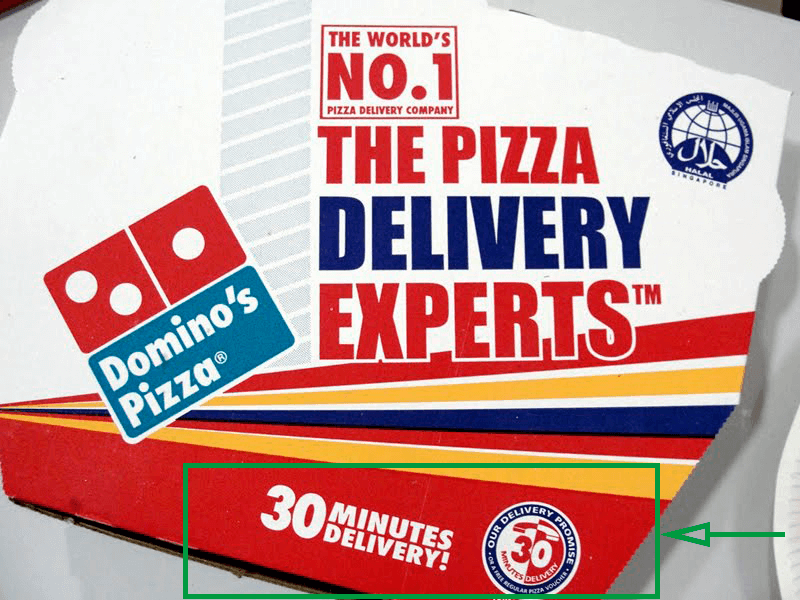
If they had only highlighted that they offered “Pizzas delivered to your home,” no matter how good their pizza was, they would not have stood out among the competition. Therefore, it is important to find something different and remarkable that makes you stand out to beat your competition.
Step 3: Select the media or channels you will use to reach your potential customers
Based on the objectives you have defined above and the information you have gathered about your customers, including their location and behavior, choose the marketing channels that you think will best allow you to reach them. Take into account your resources and then define the strategies and actions that you will use in each channel.
For this, you must also take into account the 4Ps of the marketing mix – price, product, place (distribution) and promotion Philip Kotler created the theory and defines it as “the mix of controllable marketing variables that the company uses to achieve the desired level of sales in the target market.”
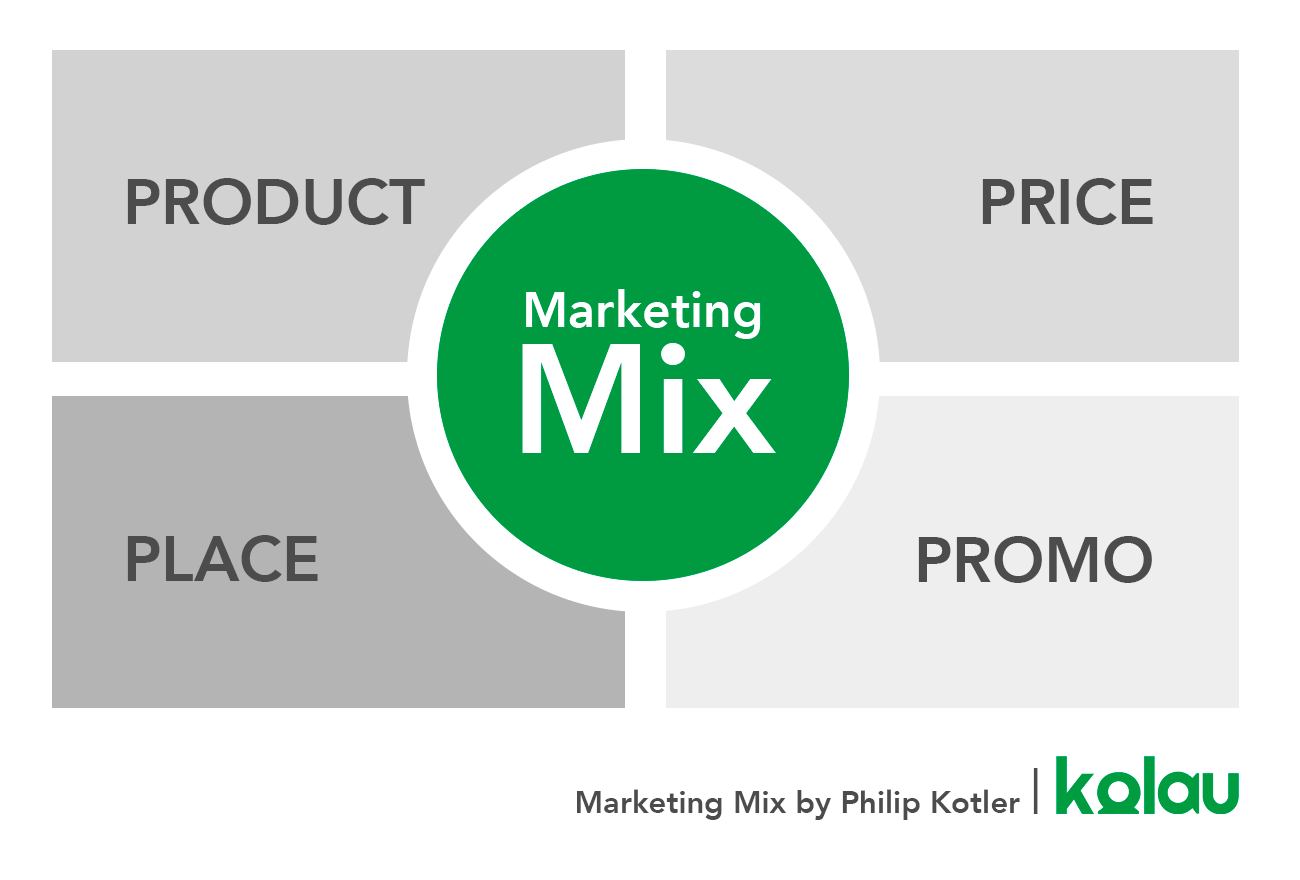
For example, suppose your company is dedicated to the sale of top-brand appliances nationwide sold through an online store with a goal to increase the sales of high-end LG smart TVs. Since you’re selling an expensive product, you can invest more into promoting the devices with less risk of a negative return.
In this same example, you know that your potential customers tend to search for your products through Google so you define Google Ads as one of your marketing channels. Here, you create Google search ads to promote this product nationwide.
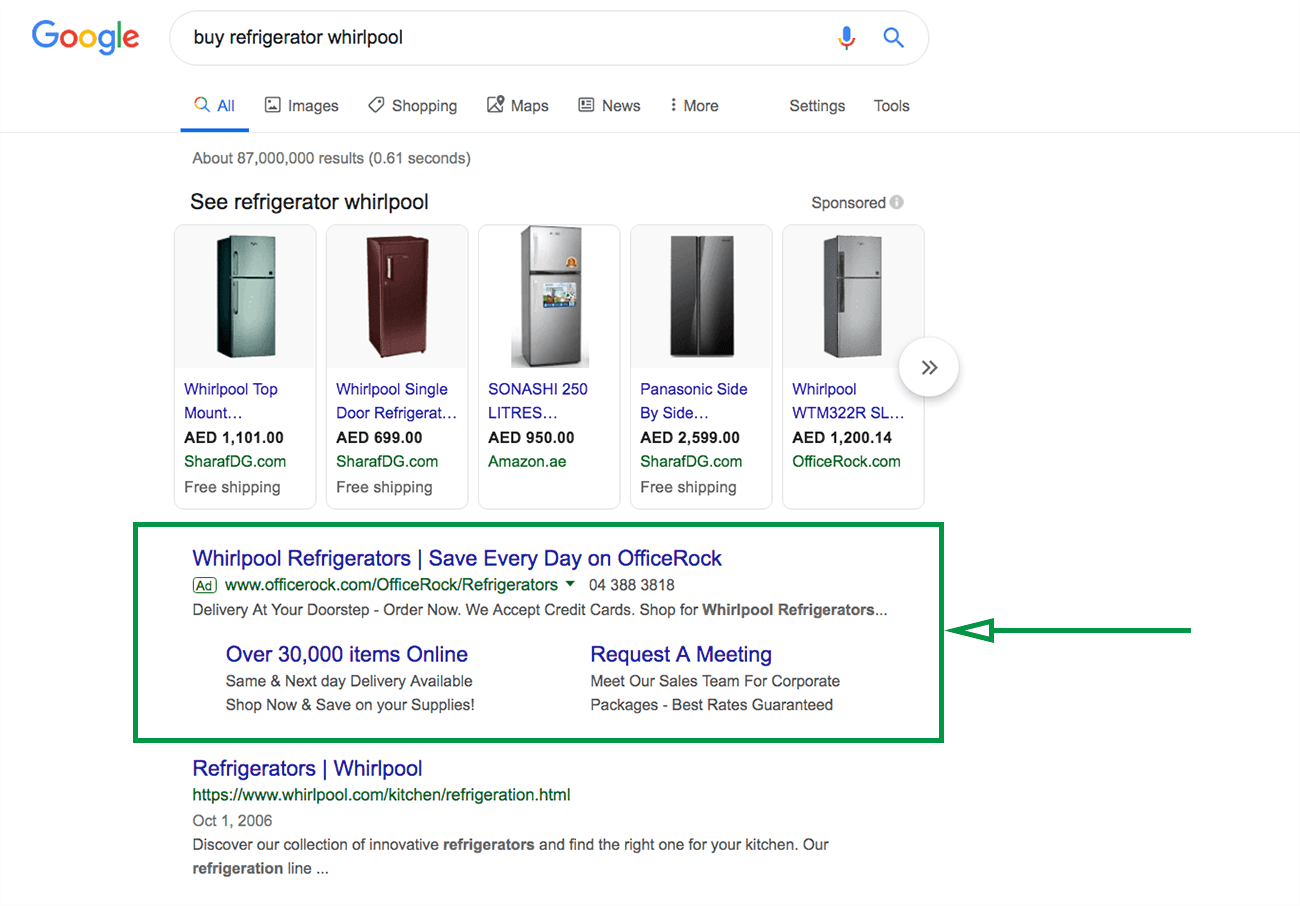
To define the channels and strategies to use in your marketing plan, you can classify them as follows:
Online marketing channels and strategies
According to the 2019 Small Business Marketing Trends Report carried out by Keap, the three online channels and tactics that more SMEs plan to use this year are social networks (48 percent), digital advertising (23 percent) and email marketing (23 percent). Here are the main channels and tactics to consider:
- Blog: Content marketing
- Search engines: SEO and search engine advertising
- Other websites and apps: Display marketing, affiliate marketing
- E-mail: E-mail marketing
- Social media: Content marketing and social media advertising
Offline marketing channels and strategies
Another survey carried out by OutboundEngine reveals that for 11.67 percent of SMEs the most successful marketing channel has been traditional advertising while 13.61 percent of SMEs say their success came from events. Here are the main offline channels and tactics to consider:
- Traditional media: Advertising or press, television and local radio appearances
- Stationery: Creation of flyers, brochures, guides and other publications
- Traditional advertising supports: Billboards, etc.
- Fairs and events: Participation in fairs and organization of events
Defining your marketing budget
It’s time to make one of the most difficult decisions, especially for SMEs: setting your marketing budget. Among small businesses, there is a general tendency to see marketing as an expense instead of an investment and this is why, according to the aforementioned OutboundEngine study, more than half of SMEs tend to spend less than 5% of their total budget on marketing.
If you look at the data provided by the OutboundEngine study, there is no doubt that investing more in marketing usually means gaining more. Specifically, 81 percent of SMEs that invested between 5 percent and 10 percent of their annual budget on marketing actions during 2018, saw their sales increase. On the other hand, those that invested less than 5 percent of their budget, experienced a decrease in their sales.
Try to find out the advertising cost of each channel you want to use to advertise your products or services and the cost of the staff you need to carry out the strategy. Then, distribute your budget based on the cost and your marketing objectives.
Once you launch your campaigns, you will know if the return you get is positive and if it would be profitable to invest more money in the channel. At this point, you may see that you’re spending more than you earn which means you must stop using that specific marketing channel.
You can find free budget templates to make this task easier on Smartsheet:
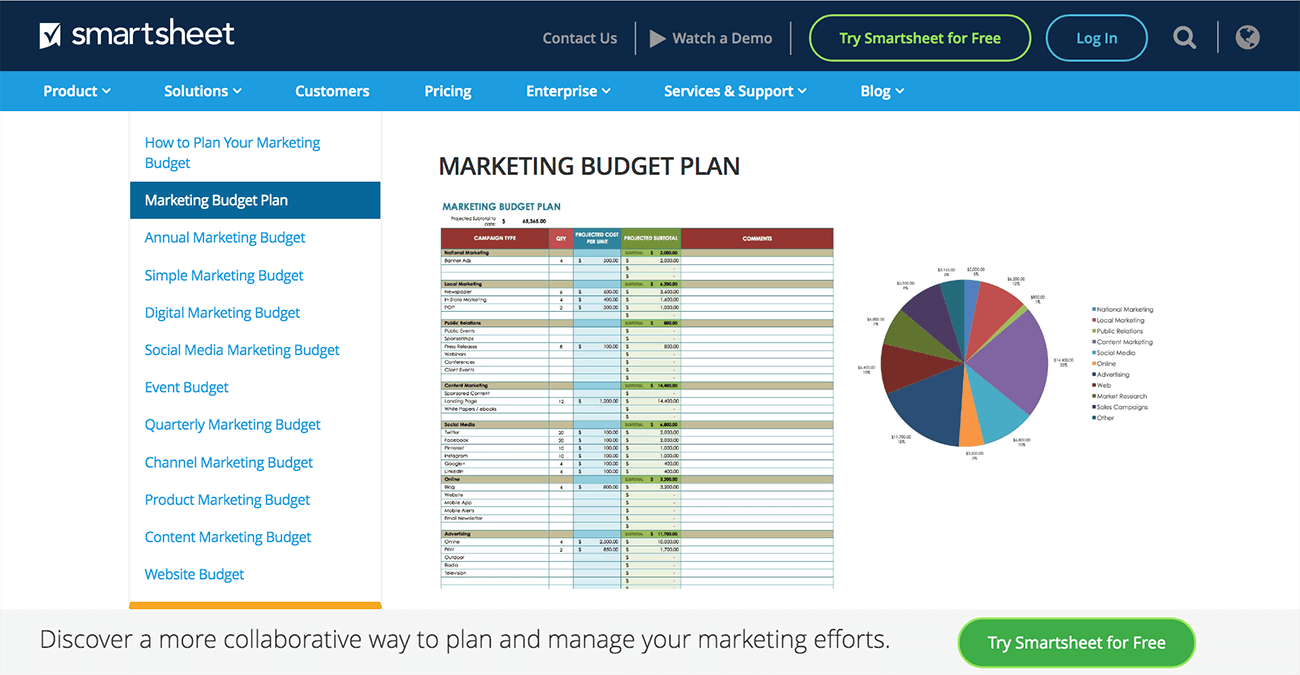
Step 4: Define your lead capture system
A lead is a potential customer that has shown interest in your product or service.
Getting a lead’s contact details and storing them in a database is key to generating more sales. Why? As an analysis by Kissmetrics demonstrates, 96 percent of visitors who come to your website are not ready to buy immediately. They may be ready in a month or a year, but if they never hear from you again, you lose them.
If you have a direct communication channel with them, you can continue sending them messages and cultivate a relationship that will eventually end up in a sale. For this reason, Allan Dib argues that you should not try to sell something directly through your ads. Instead, you should create a direct contact road with your potential customers.
To do this, you have to legally get your leads’ contact information. This is done through a lead magnet (a hook to attract potential customers).
Imagine that you are the owner of a real estate agency that sells residential houses. Your target audience is young couples looking for their first home. Instead of creating an ad that says, “buy your first home,” you decide to offer an eBook on your website with useful information about everything you need to consider before buying your first home. Your potential clients can download it for free if, in exchange, they fill out a form with their name and email.
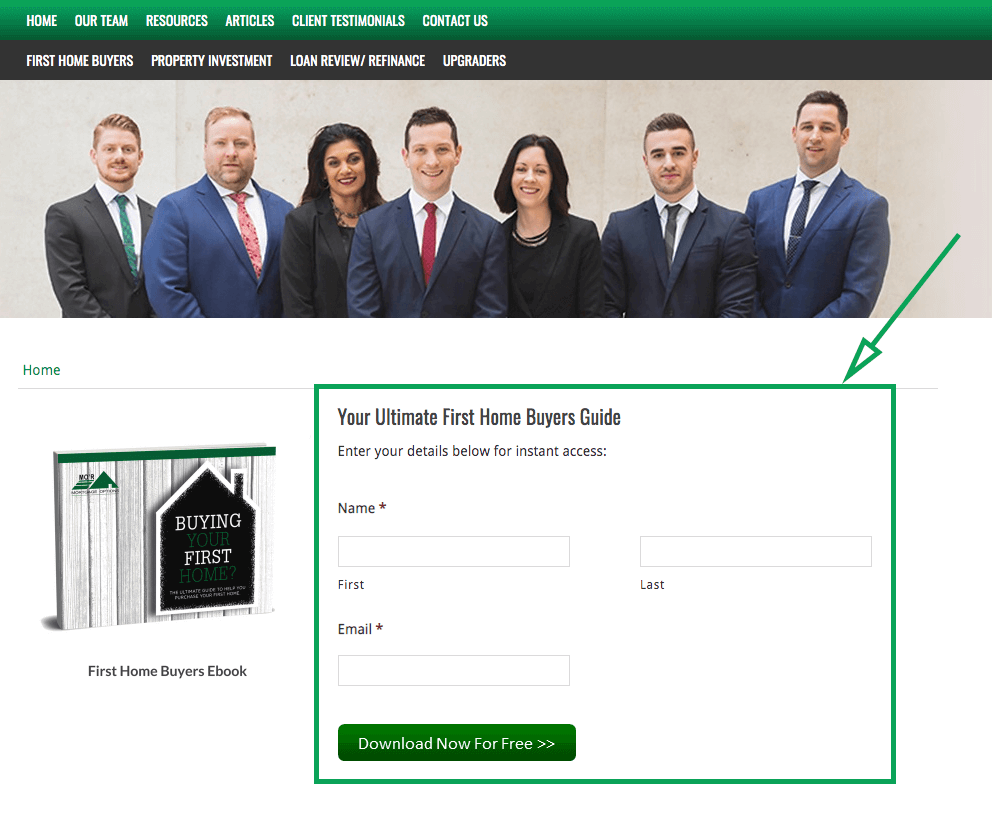
This eBook acts as a hook and will allow you to continue communicating through email with potential clients who you know are interested in buying their first home.
There are many types of lead magnets that you can use to gather contact details from potential customers. Other examples to choose from are:
- Free trials for a limited time in the case of software or applications
- Free advice or a consultation for a service
- Participation in surveys to generate individual reports
- eBooks, guides, or video series
- Coupons and/or discounts
- Opportunities for social media contests
Be sure to pick the incentive that will work best for your type of business and resources.
Step 5: Define your lead nurturing system
Once you have a database with your leads and their contact information, you have to supply them with valuable content in order to build a relationship with them that will grow into sales.
Lead nurturing is the process of ensuring that people who are vaguely interested in your product or service end up wanting it and willing to buy it.
That doesn’t mean presenting your product and asking or demanding them to buy it. If you do this, chances are your leads run out and your emails go straight to the trash or spam folder.
Send them relevant information about your industry, information on how to get the most out of what you offer or a discounted offer from time to time. Whatever you do, don’t make the traditional sales pitch.
For example, Trello, a company that designed an application to facilitate the administration and organization of projects for companies, sends its subscribers a newsletter with links to blog posts with valuable content related to their business.
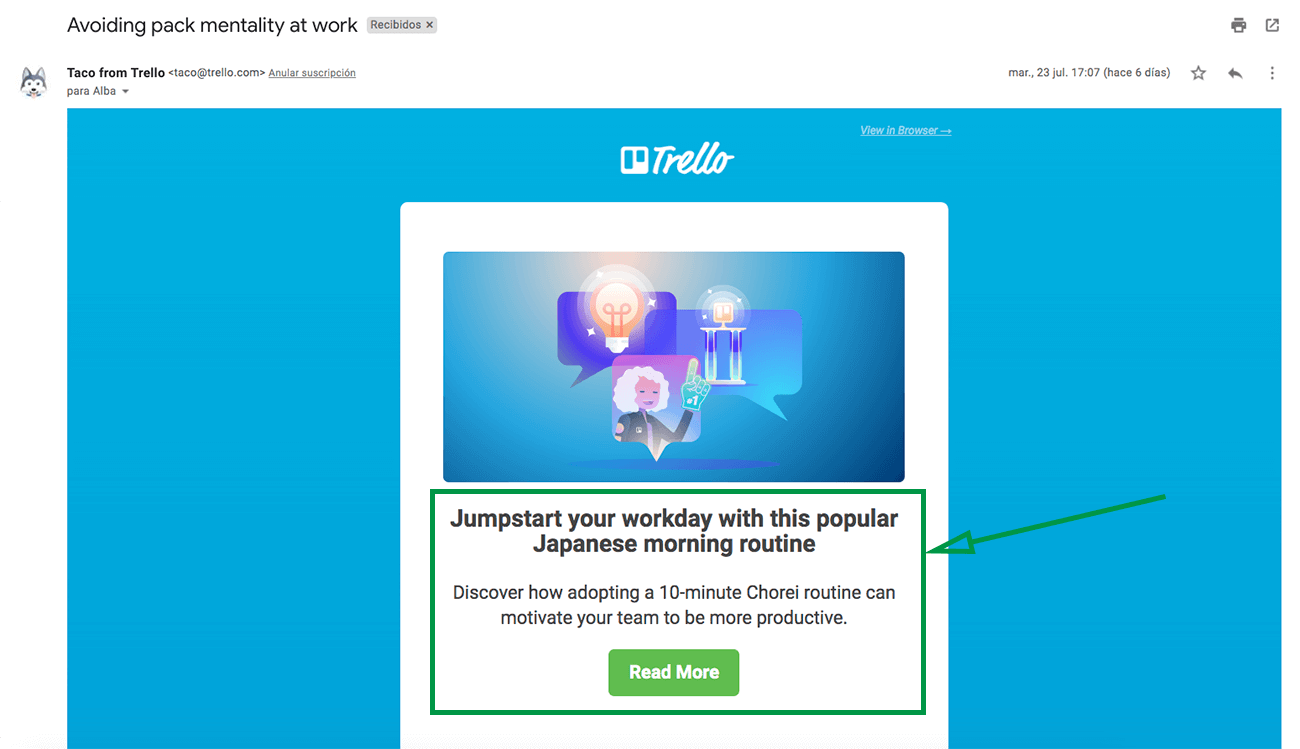
In this case, Trello invites its subscribers to discover a Japanese routine to increase productivity. This shows that they know their potential customers and that they take into account their needs and concerns in order to provide them with valuable information that doesn’t turn into a sales pitch. In this way, they can cultivate their relationship with their potential customers until they are ready to purchase their service naturally.
To have greater control of your lead nurturing system and manage it easily, it’s best to use a marketing automation software called a CRM (Client Relationship Manager). This will let you know which potential customers have taken action after reading your messages and which have not, and will automate communication with them.
There are several tools you can use to feed your leads from a blog, a newsletter, SMS and email auto responders, your social channels and sending free reports to podcasts, online videos, direct mail sequences or even handwritten notes. Each one has its advantages, so choose the ones you think best fit your customer profile.
Step 6: Define your conversion strategy
While maintaining a relationship with potential customers through valuable content is important, you have to turn to converting those potential customers into actual buyers. You can do this by building trust and showing them that your company brings them enough value to be worth buying from you and not the competition.
This is made easier by setting up a good lead nurturing system since that can help establish trust and show your value as a company. These two characteristics of a business is what helps people decide to buy a product or service from one company instead of their competition. The perception of your online business plays an important role; if this is not favorable, the conversions will not take place.
Here are some tips for you to build a credible image and an environment suitable for conversion:
- Buy a domain for your website: Do not use free domains for your website or for your email. Otherwise, your company won’t present a professional image and you will lose credibility.
- Add your company’s contact information on your website: Your phone, email and the address of your office or store must be included on your website even if you don’t sell or offer services in a physical way. Otherwise, your potential customers won’t be able to contact you or they may think that your company is fictitious or does not offer customer support.
- Avoid showing too many options or pricing plans: Two pricing plans (standard and premium) are enough, since, as a famous study by Professor Iyengar of Columbia University demonstrates, offering too many options causes a mental block in the consumer preventing them from making a purchase decision easily.
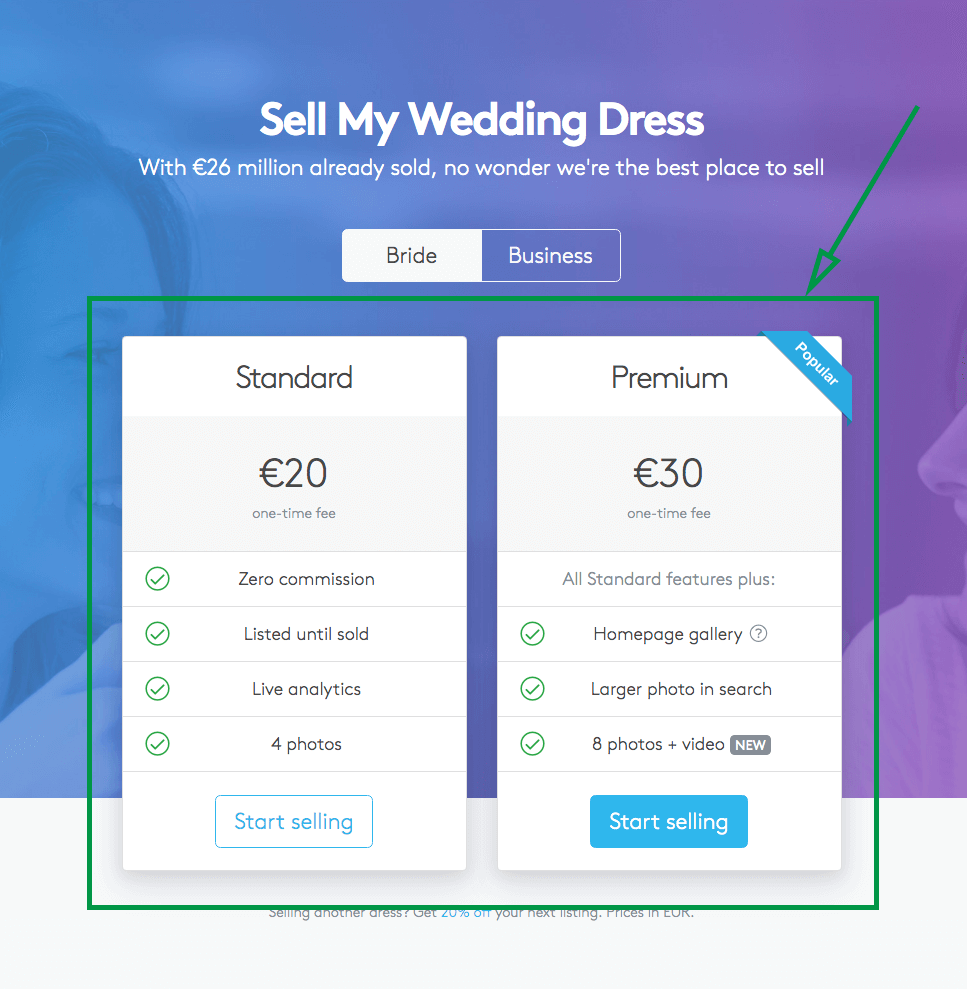
- Offer a specific guarantee to avoid uncertainty: Do not limit yourself by adding vague phrases like “guaranteed satisfaction” or “quality service” in your messages. Explain it precisely to convey more confidence. For example, “Our certified technicians with more than 10 years of experience will effectively solve any type of breakdown in your appliance and will call you back in 15 minutes. If we don’t fulfill any of these promises, we will refund twice the billable amount of the consultation.”
- Offer your customers a free trial: By doing this, you can break the sales barrier and show your potential customers that buying your product or hiring your service is worth it. This is a strategy that can dramatically increase your conversion rate. According to a study conducted by Zendesk, this can increase your conversion rate up to 30 percent.
Step 7: Define how you’ll offer a top-notch experience
Already entering the third phase (“after the purchase”) and having successfully converted potential customers into actual buyers, you have to make sure that your customers become fans of your brand so they become loyal customers who will return to buy more products or use your service again (or continuously).
Look at Apple, one of the benchmarks in this type of marketing. When they launch a new product or a simple variation of a product, their tribe of fans flood the streets to line up in front of their nearest Apple Stores to get the latest product.
So, what has Apple done and what can you do to make this phenomenon happen? The key is in selling what your customers need and being innovative.
Sell what your customers want but also what they need
You can offer the strongest anti-theft backpack in the world, but your clients also need it to be beautiful and easy to open and close. Your clients may want the most complete online software to create web pages but they need it to be easy to use or come with an effective and accessible support service.
Come up with an innovative way you sell your product or service
Innovation does not always have to be in the product or service itself. You can sell an ordinary product but come up with an innovative way to set its price, distribute it, package it or promote it.
For example, Ikea launched their Catalog application in 2013. This not only allows its customers to see the furniture catalog (ordinary product) but they can also see how each piece would fit in their domestic spaces thanks to augmented reality (innovation).
Step 8: Define how to increase the lifetime value of your customers
A marketing guide from Custora University defines the customer’s lifetime value (CLV) as a prediction of all the value that a business will obtain throughout a relationship with a consumer.
If you apply the Pareto Principle, also known as the 80/20 rule, to this concept you could say that 80 percent of your income comes from 20 percent of your customers. Although these percentages are not exactly like that, it is about identifying the customers that bring more value to your business either because they are willing to pay more, buy more frequently, recommend your services, contribute ideas or consume less resources. Once you identify them, you have to figure out how to increase their value.
There are several tactics you can use to “filter” your customers and identify which ones are the most valuable in order to increase their value.
Increase your prices
How long has it been since you increased the prices of your products or services? As previously stated, if you are able to offer a value to your customers that goes beyond the price, increasing it slightly shouldn’t be a problem for many of your customers, provided you give them a valid reason for doing so.
Explain to them the benefits they’ll get with your products or services and how this price increase will allow them to enjoy your future innovations. Inevitably, some of your clients will leave, but those who remain will be the most valuable and you will have managed to increase their value even more by raising the prices.
Use upselling strategies
Upselling is a sales technique that involves inducing a consumer to buy a more expensive item. Many times it also involves promoting more advantageous services, product packs or offers when buying complementary products.
Surely more than once you’ve gone to a fast food restaurant and they have asked you if you wanted to add fries or a larger drink to your meal for an additional charge. Better yet, if you use Spotify to listen to music, you have encountered this type of message when you signed up for the free plan:
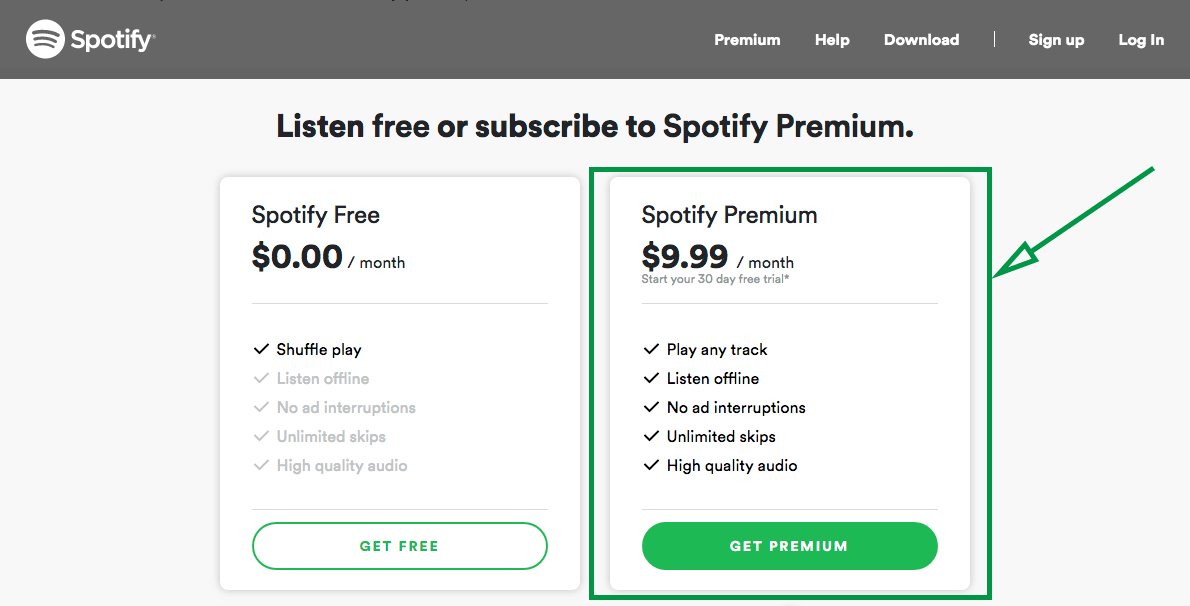
These are nothing more than upselling techniques. You can apply upselling to your business to increase the lifetime value of your customers. A formula that usually works (and one that you have surely seen on Amazon) is to add a section to your website that says: “Users who bought (X) also bought (Y).”
Give your customers a reason to come back
Increasing how often your customers usually buy from you is also a solid marketing strategy that you can apply to increase value. Offering them a subscription option so that each month they can receive your products or services at a more advantageous price is one way to do this.
There are several types of business that, by nature, already lend themselves to a subscription service. Utility contracts come to mind first but it is also possible to apply it to other types of business or products that involve a recurring purchase.
Look at Harry’s or The Dollar Shave Club, for example. These brands of razors have created a subscription service for recurring products thus eliminating the need to make an individual purchase decision whenever a customer needs to purchase new blades, foam or shaving lotions.
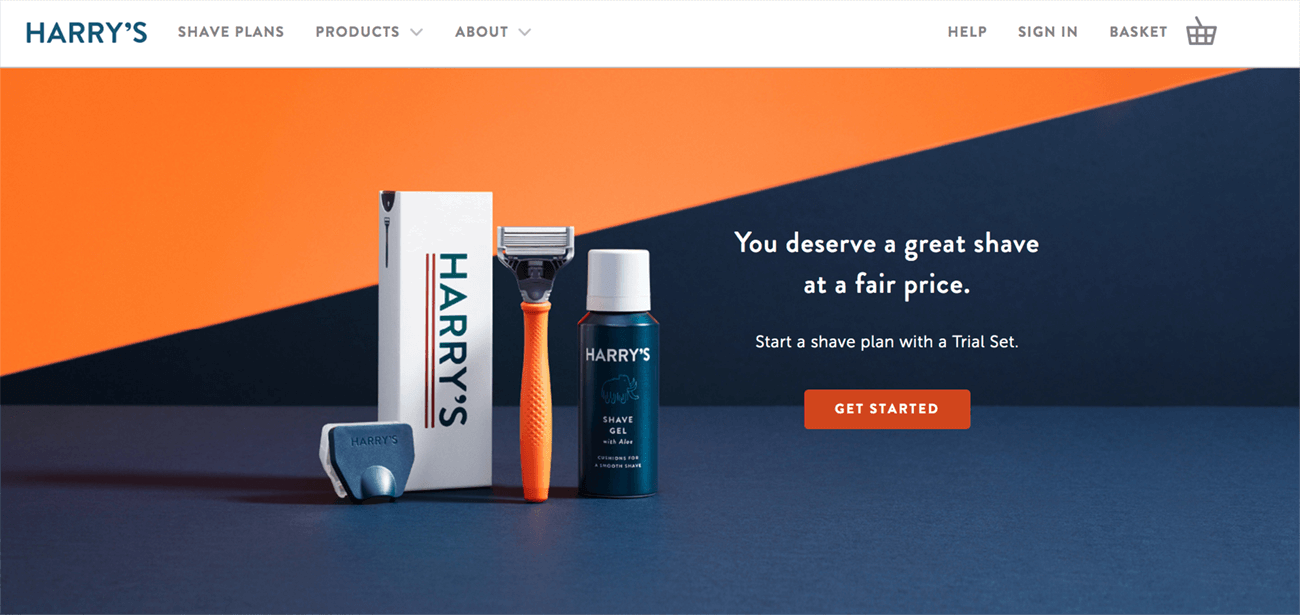
Another way to get your customers back is through a reactivation campaign. To do this, check your database to find old customers who have not made a purchase for a long time and send them a message in which you tell them that you miss them. Include a tempting offer like a coupon or a gratuity to persuade them to make another purchase.
Measure the performance of your strategies
A marketing plan is not a static document; you have to leave room for change and adapt it constantly. From all the strategies and channels you define, there will be some that will work better and others that will work worse so it’s important to know how to measure the success of your actions to identify which ones you should keep, improve or eliminate in order to get more valuable customers.
The key performance indicators that you should look at (and analyze periodically, either monthly or weekly) are mainly the following:
- The number of leads
- Your conversion rate
- The average transaction value
- Your break-even point
Step 9: Define your referral program
Word of mouth marketing is one of the most powerful strategies to improve the positioning of a business and increase sales exponentially. According to a study by Nielsen, 92 percent of consumers believe more in the recommendations of friends and family than in advertising.
However, many entrepreneurs are waiting for this phenomenon to happen naturally as a result of the great quality of their product or service. The fact is that if you wait for positive reviews to come in on their own, it can take a long time to get results, so it’s better to take action.
Ask your customers to recommend your product or service in exchange for an incentive. For example, an upgrade in their current service plan or a discount on future purchases.
One of the most famous recommendation programs has undoubtedly been that of Dropbox, the popular cloud storage company. Dropbox offered more free space (specifically, 500 MB) for both the new customer and the recommender. This simple strategy allowed them to increase the number of registered users by 60 percent.
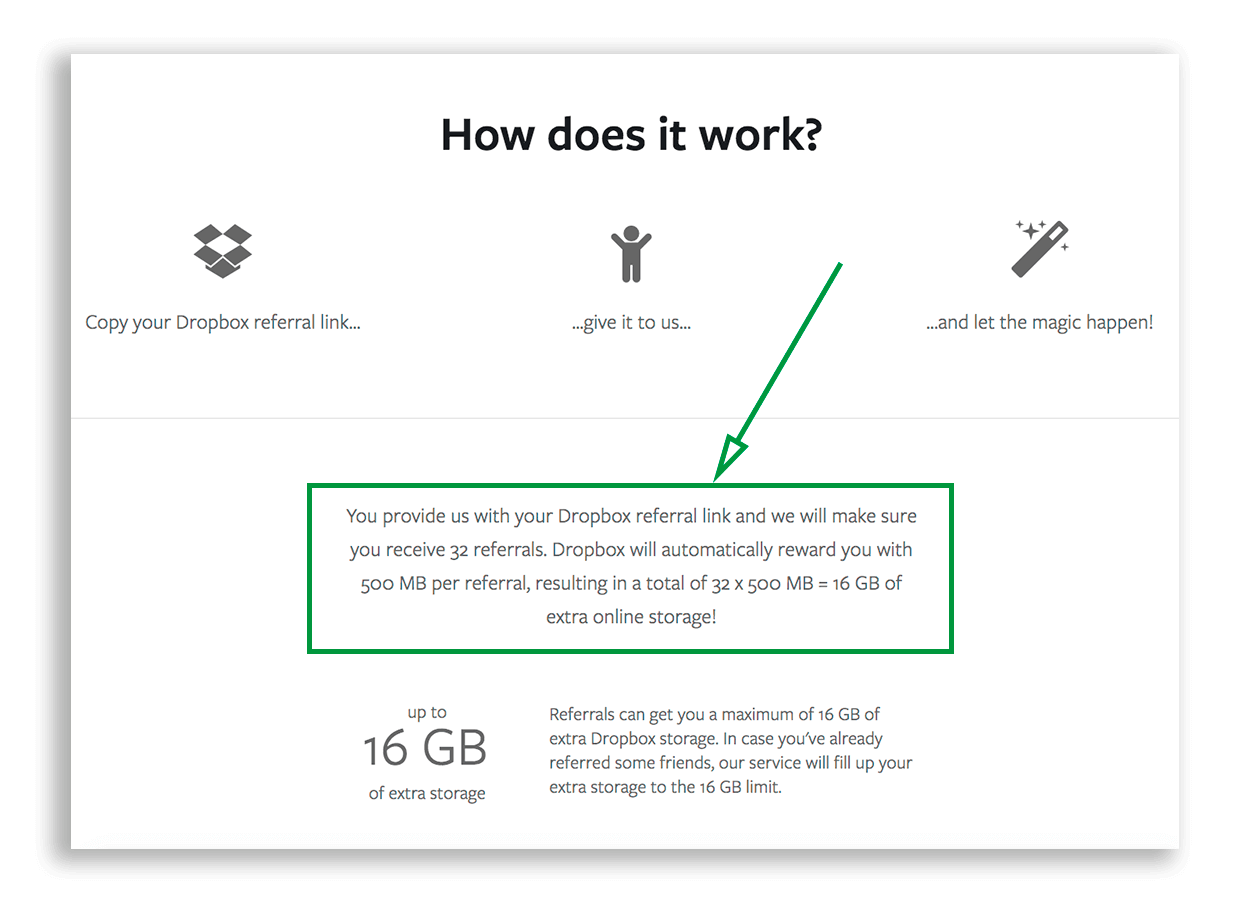
Now you know how to make a strategic marketing plan for your company and how to optimize the efforts and resources you allocate to marketing to grow your business. Remember that your marketing plan must continually adapt to the market and that your success can multiply if you optimize and renew your strategies based on the results of your key performance indicators.




















